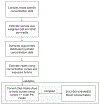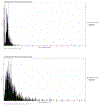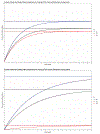Computational estimates of daily aggregate exposure to PFOA/PFOS from 2011 to 2017 using a basic intake model
- PMID: 34373583
- PMCID: PMC10568366
- DOI: 10.1038/s41370-021-00374-w
Computational estimates of daily aggregate exposure to PFOA/PFOS from 2011 to 2017 using a basic intake model
Abstract
Background: Human exposure to per- and polyfluoroalkyl substances has been modeled to estimate serum concentrations. Given that the production and use of these compounds have decreased in recent years, especially PFOA and PFOS, and that additional concentration data have become available from the US and other industrialized countries over the past decade, aggregate median intakes of these two compounds were estimated using more recent data.
Methods: Summary statistics from secondary sources were collected, averaged, and mapped for indoor and outdoor air, water, dust, and soil for PFOA and PFOS to estimate exposures for adults and children. European dietary intake estimates were used to estimate daily intake from food.
Results: In accordance with decreased concentrations in media, daily intake estimates among adults, i.e., 40 ng/day PFOA and 40 ng/day PFOS, are substantially lower than those reported previously, as are children's estimates of 14 ng/day PFOA and 17 ng/day PFOS. Using a first-order pharmacokinetic model, these results compare favorably to the National Health and Nutrition Examination Survey serum concentration measurements.
Conclusion: Concomitant blood concentrations support this enhanced estimation approach that captures the decline of PFOA/PFOS serum concentration over a decade.
Keywords: Aggregate daily; Exposure model; PFOA; PFOS.
© 2021. This is a U.S. government work and not under copyright protection in the U.S.; foreign copyright protection may apply.
Conflict of interest statement
COMPETING INTERESTS
The authors declare no competing interests.
Figures




Similar articles
-
Children's exposure to perfluoroalkyl acids - a modelling approach.Environ Sci Process Impacts. 2019 Nov 1;21(11):1875-1886. doi: 10.1039/c9em00323a. Epub 2019 Sep 24. Environ Sci Process Impacts. 2019. PMID: 31549993
-
Perfluorochemicals in meat, eggs and indoor dust in China: assessment of sources and pathways of human exposure to perfluorochemicals.Environ Sci Technol. 2010 May 1;44(9):3572-9. doi: 10.1021/es1000159. Environ Sci Technol. 2010. PMID: 20377175
-
Levels of perfluorinated compounds in food and dietary intake of PFOS and PFOA in the Netherlands.J Agric Food Chem. 2011 Jul 13;59(13):7496-505. doi: 10.1021/jf104943p. Epub 2011 Jun 10. J Agric Food Chem. 2011. PMID: 21591675
-
Per- and polyfluoroalkyl substances: toxicokinetics, exposure and health risks.J Toxicol Sci. 2025;50(3):97-104. doi: 10.2131/jts.50.97. J Toxicol Sci. 2025. PMID: 40024759 Review.
-
Per- and Polyfluoroalkyl Substances (PFASs) in Food and Human Dietary Intake: A Review of the Recent Scientific Literature.J Agric Food Chem. 2017 Jan 25;65(3):533-543. doi: 10.1021/acs.jafc.6b04683. Epub 2017 Jan 12. J Agric Food Chem. 2017. PMID: 28052194 Review.
Cited by
-
Exposure to per- and polyfluoroalkyl substances (PFAS) in North Carolina homes: results from the indoor PFAS assessment (IPA) campaign.Environ Sci Process Impacts. 2025 Jun 18;27(6):1654-1670. doi: 10.1039/d4em00525b. Environ Sci Process Impacts. 2025. PMID: 39526893
-
A Scoping Assessment of Implemented Toxicokinetic Models of Per- and Polyfluoro-Alkyl Substances, with a Focus on One-Compartment Models.Toxics. 2023 Feb 9;11(2):163. doi: 10.3390/toxics11020163. Toxics. 2023. PMID: 36851038 Free PMC article. Review.
-
Linking exposure to per- and polyfluoroalkyl substances (PFAS) in house dust and biomonitoring data in eight impacted communities.Environ Int. 2024 Jun;188:108756. doi: 10.1016/j.envint.2024.108756. Epub 2024 May 17. Environ Int. 2024. PMID: 38795657 Free PMC article.
-
Effects of short-chain per- and polyfluoroalkyl substances (PFAS) on human cytochrome P450 (CYP450) enzymes and human hepatocytes: An in vitro study.Curr Res Toxicol. 2023 Jul 21;5:100116. doi: 10.1016/j.crtox.2023.100116. eCollection 2023. Curr Res Toxicol. 2023. PMID: 37575337 Free PMC article.
-
Human exposure pathways to poly- and perfluoroalkyl substances (PFAS) from indoor media: A systematic review.Environ Int. 2022 Apr;162:107149. doi: 10.1016/j.envint.2022.107149. Epub 2022 Feb 28. Environ Int. 2022. PMID: 35240384 Free PMC article.
References
-
- Agency for Toxic Substances Disease Registry. Toxicological profile for perfluoroalkyls. Draft for public comment. Updated June 2018. Atlanta, Georgia: US Department of Health and Human Services, Public Health Service. http://www.atsdr.cdc.gov/toxprofiles/tp200.pdf (2018). Accessed 31 Aug 2020.
-
- US Environmental Protection Agency. Perfluoroalkyl sulfonates; Significant New Use Rule. 40 CFR 721 ed. Federal Register; 2002. 72854–67.
-
- US Environmental Protection Agency. PFAS action plan: program update February 2020, Research Triangle Park, North Carolina: Office of Air Quality Planning & Standards. Updated February 27, 2020. https://www.epa.gov/pfas/pfas-action-plan-program-update-february-2020 (2020). Accessed 31 Aug 2020.
-
- Egeghy PP, Lorber M. An assessment of the exposure of Americans to perfluorooctane sulfonate: a comparison of estimated intake with values inferred from NHANES data. J Exposure Sci Environ Epidemiol. 2011;21:150–68. - PubMed
-
- Lorber M, Egeghy PP. Simple intake and pharmacokinetic modeling to characterize exposure of Americans to perfluoroctanoic acid, PFOA. Environ Sci Technol. 2011;45:8006–14. - PubMed
Publication types
MeSH terms
Substances
Grants and funding
LinkOut - more resources
Full Text Sources
Miscellaneous

